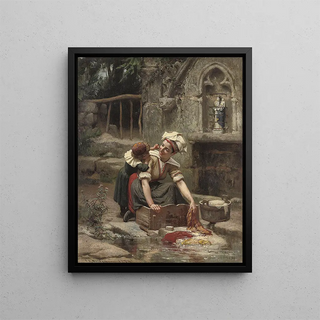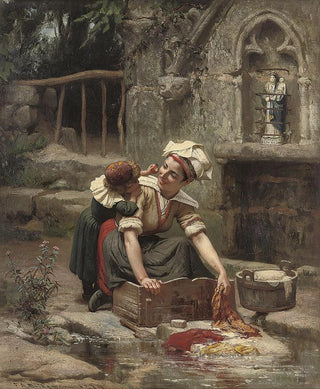Art print | Le Petit assistant de maman - Frederick Arthur Bridgman


View from behind

Frame (optional)
In the enchanting world of art, some works manage to capture the very essence of everyday life with such finesse that they transcend the simple frame of the canvas. "Le Petit assistant de maman" by Frederick Arthur Bridgman is one of these creations. Painted at the end of the 19th century, this piece evokes not only an intimate scene but also an era when childhood was celebrated in all its splendor. The artist, skillfully playing with light and shadow, invites us to enter a moment of shared tenderness between a mother and her child, a frozen instant that resonates with warmth and nostalgia.
Style and uniqueness of the work
Bridgman's style is distinguished by its realistic approach, skillfully blending impressionist elements. In "Le Petit assistant de maman," the chosen color palette evokes infinite softness, with warm tones that envelop the scene in a comforting halo. The light, seemingly filtering through a window, illuminates the child's face, emphasizing innocence and curiosity. Every detail, from the fabric of the clothing to the delicate expressions of the characters, reflects meticulous attention to the depiction of domestic life. This work does not merely depict a mother and her son; it tells a story, that of a deep and unbreakable bond, through a rich and evocative visual language.
The artist and his influence
Frederick Arthur Bridgman, born in 1847, was an American painter whose artistic journey was marked by diverse influences, ranging from realism to impressionism. His stay in France, where he mingled with other great masters, undoubtedly shaped his style. Bridgman is known for his genre scenes, often inspired by daily life, but also for his landscapes that reflect his love for nature. His work, both accessible and imbued with depth, has touched many artists and art enthusiasts. By depicting simple yet emotionally charged moments, he paved the way for a new appreciation of domestic life, placing the human at the heart of his art.
Wall decoration

Matte finish

View from behind

Frame (optional)
In the enchanting world of art, some works manage to capture the very essence of everyday life with such finesse that they transcend the simple frame of the canvas. "Le Petit assistant de maman" by Frederick Arthur Bridgman is one of these creations. Painted at the end of the 19th century, this piece evokes not only an intimate scene but also an era when childhood was celebrated in all its splendor. The artist, skillfully playing with light and shadow, invites us to enter a moment of shared tenderness between a mother and her child, a frozen instant that resonates with warmth and nostalgia.
Style and uniqueness of the work
Bridgman's style is distinguished by its realistic approach, skillfully blending impressionist elements. In "Le Petit assistant de maman," the chosen color palette evokes infinite softness, with warm tones that envelop the scene in a comforting halo. The light, seemingly filtering through a window, illuminates the child's face, emphasizing innocence and curiosity. Every detail, from the fabric of the clothing to the delicate expressions of the characters, reflects meticulous attention to the depiction of domestic life. This work does not merely depict a mother and her son; it tells a story, that of a deep and unbreakable bond, through a rich and evocative visual language.
The artist and his influence
Frederick Arthur Bridgman, born in 1847, was an American painter whose artistic journey was marked by diverse influences, ranging from realism to impressionism. His stay in France, where he mingled with other great masters, undoubtedly shaped his style. Bridgman is known for his genre scenes, often inspired by daily life, but also for his landscapes that reflect his love for nature. His work, both accessible and imbued with depth, has touched many artists and art enthusiasts. By depicting simple yet emotionally charged moments, he paved the way for a new appreciation of domestic life, placing the human at the heart of his art.
Wall decoration






